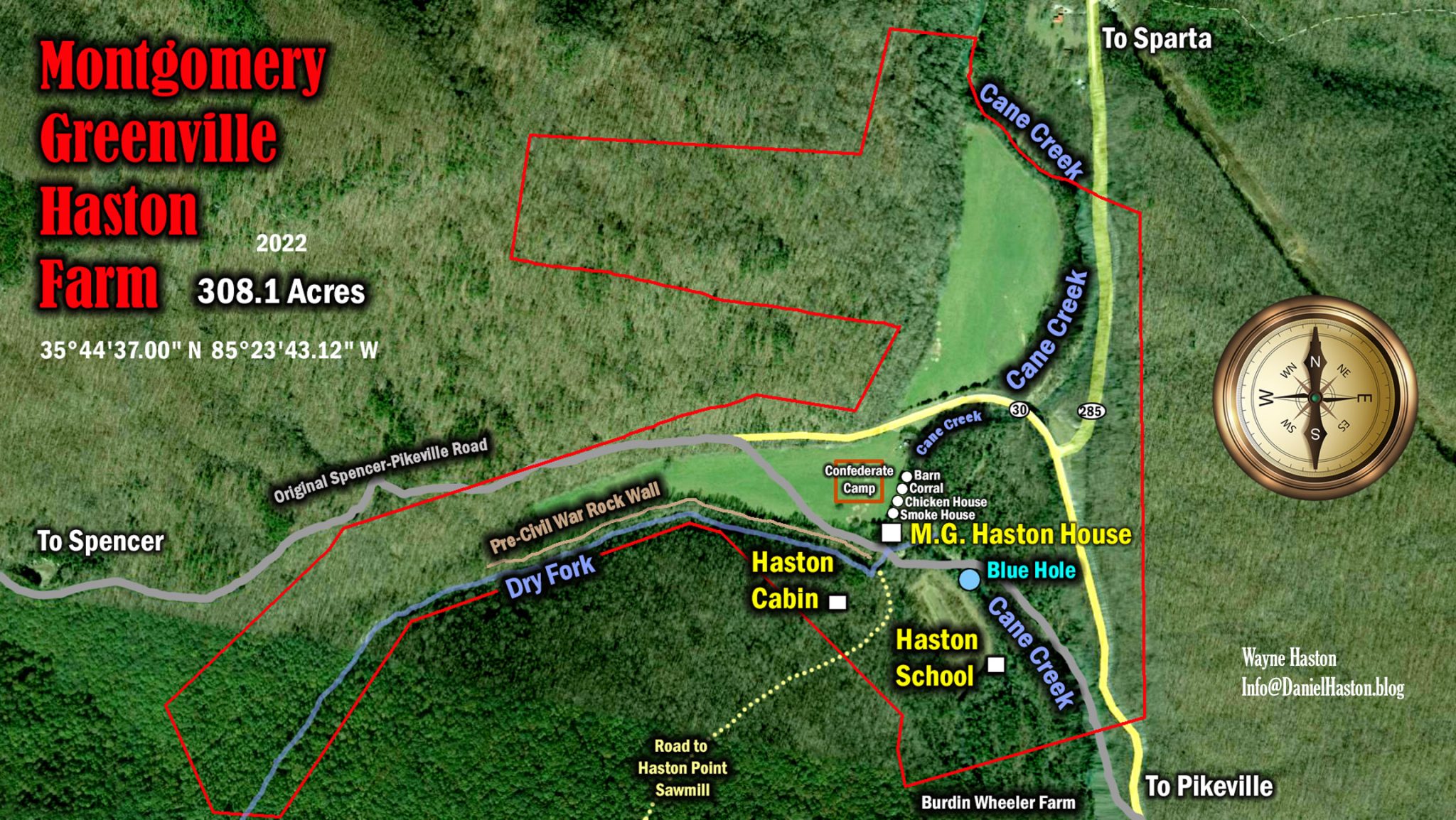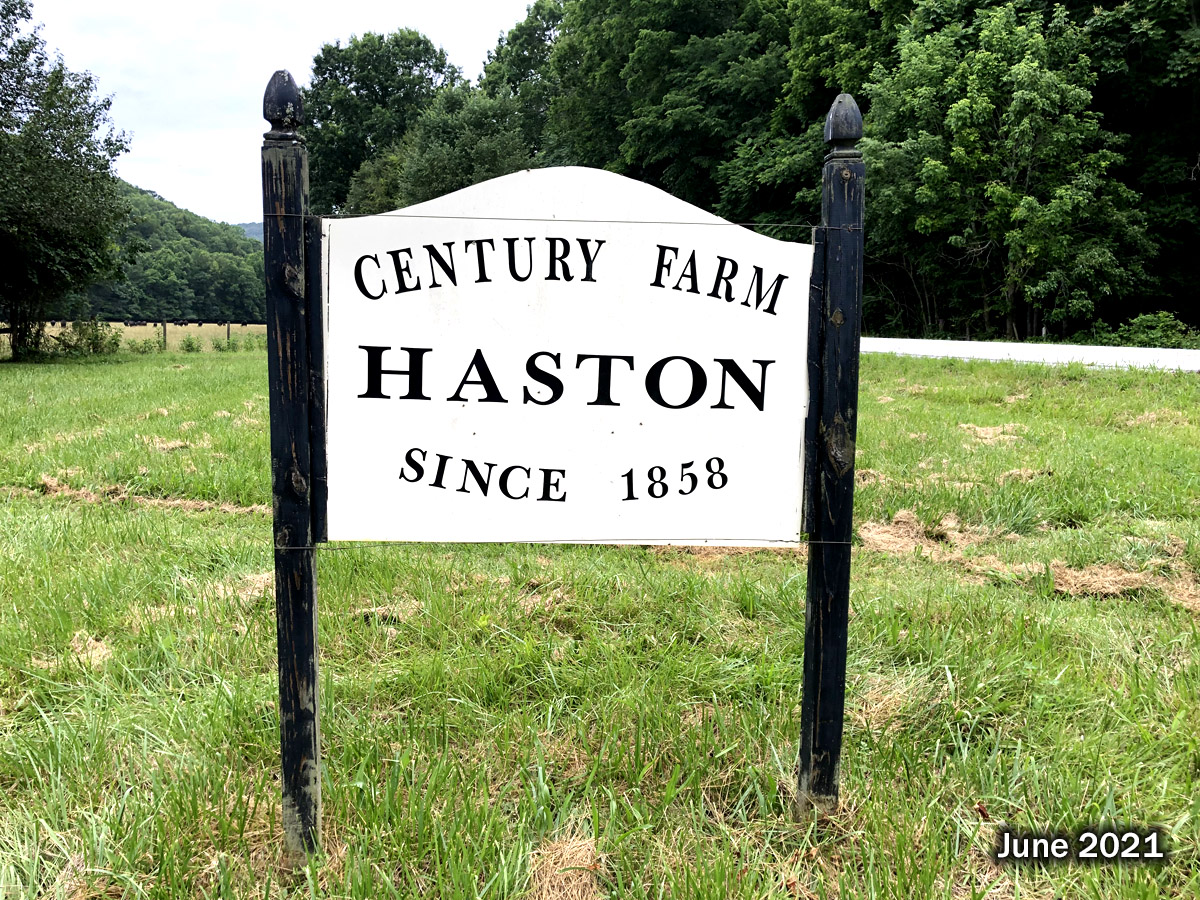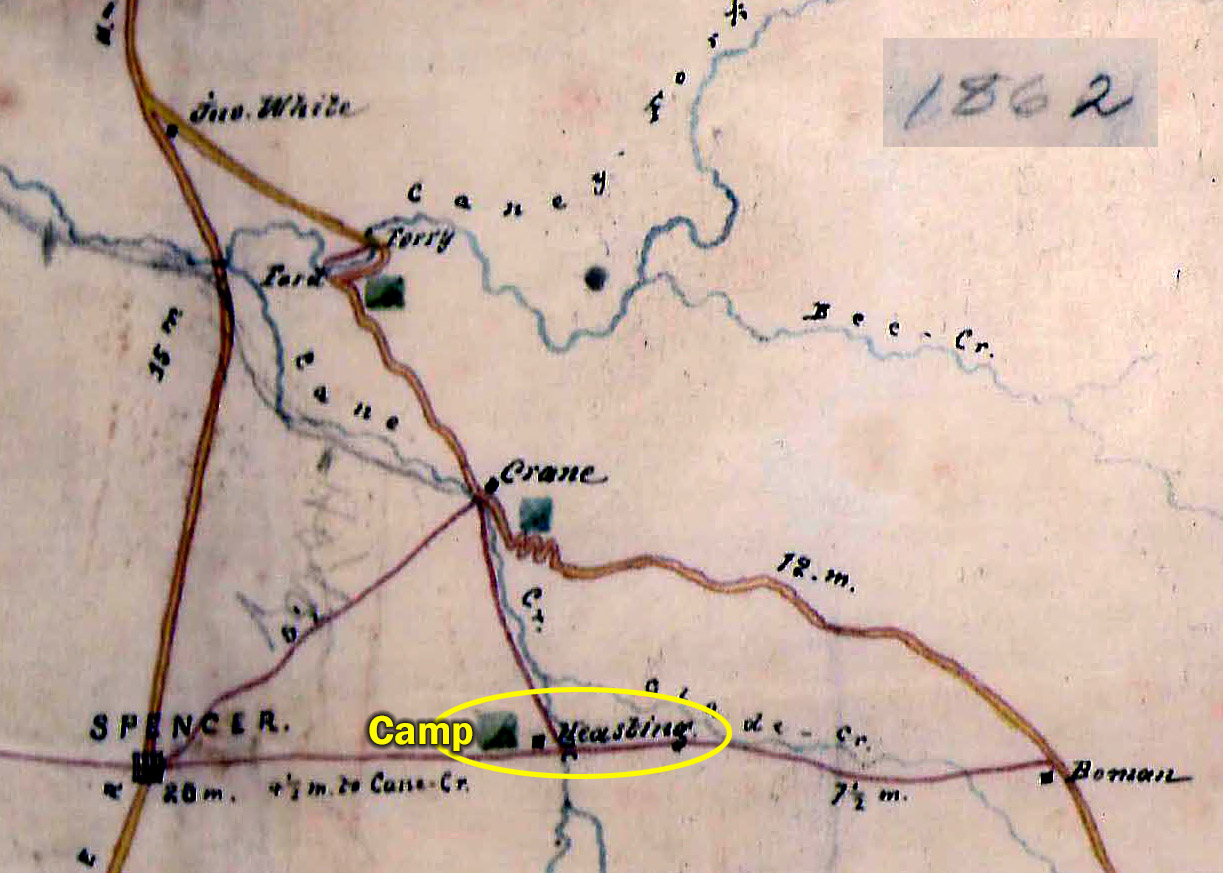Montgomery Greenville Haston Farm
The Core of M.G. Haston's 1858 Farm - Today a Tennessee Century Farm

On November 3, 1858, Montgomery G. Haston (grandson of David Haston, Great Grandson of Daniel) bought four tracts of land (1,163 acres more or less) from Nathan Durham for $900.[i] The land was located around the current crossroads of Highways 30 and 285 on Cane Creek in Van Buren County, TN. From the documents we have, it appears he paid cash for the land. M.G. acquired a few other tracts of land in the years to follow. In 1860, he owned 1,289 acres. After M.G.’s death on December 20, 1869, the farm was divided and gradually parts of the original farm were sold outside of the family. Much of his acreage was steep and of little value. But the Dry Fork Branch and Cane Creek bottom land, the core of the M.G. Haston farm, has provided pasture for cattle for many decades. [i]Van Buren County, Tennessee Deed Book B, 548-549.

The core 308 acres of the Montgomery G. Haston farm have remained in the Haston family until now. In 2020, Jean Ann (Haston) Hall and her brother David Haston placed the farm in a legacy trust to assure that it remains in the Haston family for many years to come. It’s the 3rd oldest Century Farm in Van Buren County and still, up to 25 cows and calves graze on each of the farms (upper and lower) pastures each summer.

Earliest Haston Ownership of this Haston Farm
Montgomery Greenville Haston was not the first Haston to own land in this area of the upper Cane Creek valley. David Haston’s oldest son, Wiley Blount Haston, was granted 50 acres (Grant No. 1495) there based on a June 15, 1829 survey.
By virtue of Entry No. 2121 and a June 19, 1832 survey, Isham Bradley Haston (brother of Wiley B. Haston, both sons of David) was granted 25 acres (Grant No. 3320) that joined Wiley B.’s (above mentioned) 50 acres. The State of Tennessee official seal was officially affixed on April 2, 1834.
Isham B. Haston made Entry No. 3011 (Grant No. 12503?) on August 4, 1837 for 135 acres (by an October 9, 1838 survey) on the waters of Cane Creek. The survey began near the mouth of the Dry Hollow.
On July 5, 1841, Isham B. Haston sold 53 acres on the west side of Cane Creek (at the foot of a high rocky mountain) to Nathan Durham for $325. Wilie B. Haston witnessed the transaction.
In those days, it was common for ownership of real estate to change frequently. Nathan Durham, apparently, accumulated several tracts of land in the upper valley of Cane Creek. Based on the probable location of the tracts mentioned above, all of these tracts may have been (or were probably) portions of the 1,163 acres that M.G. Haston purchased from Nathan Durham in 1858.
There is evidence that in his young single adult and single years, M.G. Haston probably lived with (or on the land of) Wiley B. Haston or Isham B. Haston. He was elected as constable there in August 1845. That’s undoubtedly where he met Rachel Wheeler whom he married in 1847
When M.G. Haston returned from a five-year hiatus in Walker County, GA, he was familiar with the land he purchased from Nathan Durham in November 1858.
So, some of the land that is now part of the Haston Century Farm was in the Haston family well before the 1858 Century Farm beginning date.
Significant Location of the M.G. Haston Farm
Besides its location at the crossroads of highways going to and from Spencer, Pikeville, and Sparta, the M.G. Haston farm encompasses approximately one mile of Cane Creek. The water of Cane Creek that runs through the Haston farm tumbles over Fall Creek Falls and Cane Creek Falls, about 4.5 miles upstream. The location of M.G. Haston’s farm was both a blessing and a curse in earlier years, as you will see in the following section.
Historical Features of the Farm
Prior to 1858, we don’t know much about what happened on the tracts that M.G. Haston acquired, but doubtless, there is a lot of interesting history hidden away there. There is quite a bit of interesting historical information that is known about the farm after M.G. purchased the land in 1858. Here are a dozen of some of the more interesting known historical features on and around the farm.
Indian Camp
Buckets of Indian arrowheads have been recovered from the Haston farm, especially in the field west of the Blue Hole on Cane Creek.
M.G. Haston Home and Out-Buildings
The M.G. Haston home, which was also the home of his descendants, was located on the north side of the old Spencer to Pikeville Road and the Dry Fork and just west of Cane Creek. There was a smokehouse, a chicken house, a corral, and a barn located north of the house. This original M.G. Haston house burned in the early 1940s.
The large upstairs bedroom was filled with multiple beds that Emma Lewis Haston rented out to loggers, road builders, hunters, and fishermen. She ran a bed and breakfast and had many repeat customers.
Pre-Highway 30 Road
Prior to the early 1930s, when what is now the foundation of Highway 30, the old road cut across the M.G. Haston farm along the gray route on the above plat-map. The road ran very near M.G. and Rachel Haston’s house, apparently crossed Cane Creek (probably) below the Blue Hole, then ran up the side of the mountain and connected to pre-Highway 30 road that goes to the Mooneyham community and on to (past the north entrance of Fall Creek Falls State park) to Pikeville, TN.
As per Marlin’s recollections, this was a fairly busy road and the Blue Hole in the Cane Creek was a watering place and resting stop for the horses and mules used for transportation at that time.
Here’s the “curse” part of the location. Some of the people who traveled the roads that criss-crossed essentially in the front yard of M.G. Haston’s house were bad people. That was especially true during, and in the years following, the Civil War. Marlin Haston stated that grandmother Rachel Haston sat in a rocking chair every night with a loaded shotgun across her lap. She was afraid of raiders and other evil-minded rascals. Think about it–in the latter two years of the war, the county was controlled by Federal soldiers and M.G. Haston’s family was a marked family because of his previous involvement as a Confederate Home Guard Captain and, later a soldier.
Dry Fork of Cane Creek
This (sometimes) dry branch merges with Cane Creek behind the site where M.G. Haston’s house was located. Occasionally, “Dry Fork” floods destructively across the Haston property south of Hwy 30, especially since Hwy 111 was built, from Spencer to Dunlap.

Pre-Civil War Rock Wall
A wall constructed of large creek stones runs along the north side of Dry Fork. According to the story passed down through the Haston family, the wall was built prior to the Civil War. One theory is that it was put there to help control the damaging torrent of water that rushed down the branch in extreme flooding times.
Alongside the rock wall’s northern edge are the remains of a road that runs completely through the farm, heading west up the hollow. “Widow Carter,” widow of Captain George Carter (Confederate guerilla) lived up the road in this hollow after the Civil War. Captain Carter was killed in the first battle of Saltville, VA.

Confederate Civil War Camp
M.G. Haston was Captain of the Home Guard in his Van Buren County district. According to an 1862 Confederate Civil War map, there was a Confederate camp (the dark green square) on his property, in front of his house and out-buildings. After the Union Army took control of Van Buren County, this would have been an extremely dangerous place for Rachel Haston and her children to live, while M.G. was fighting in the Confederacy. And after M.G. returned home from Chattanooga to protect his family from Yankee soldiers who were looking for pro-Confederate families to harass and ex-Confederate soldiers to kill, M.G. was constantly in danger of being captured and killed.

Caves
Multiple caves exist on the M.G. Haston farm and the land he once owned. Perhaps M.G. hid in one of these caves at the time Federal soldiers were hunting for him, an ex-Confederate soldier and former Home Guard Captain.

Blue Hole
This deep pool of water in Cane Creek, near (south east of) the M.G. Haston home was used for many years as a popular swimming hole for locals, as well as a Sunday baptismal pool for churches in Spencer. Church members would pack lunches and would enjoy a picnic at the Blue Hole for baptisms. It was very busy on many Sundays.

Haston Cabin
A little cabin was located up a slope south of Dry Fork. According to oral history within this Haston family, it is believed that the cabin was built in the late 1800s. Various family members used it through the years. Robert Charles Haston, Sr. and his bride, Mary Etta Smith, used it as their first home. Marlin Haston was born there in 1928 and spent the first six or seven years of his life growing up on the farm. His brother, R.C. Haston, Jr., was born there as well. Marlin described the farm as being a very busy place. The old road (prior to the current Highway 30) ran between this cabin and the house that M.G. and Rachel Wheeler Haston had lived in. The logging road to the Haston sawmill, on Haston Point, ran to the east side of the cabin and on up the mountain. This was a busy crossroads in the pre-1940s history of the Cane Creek valley.

Haston School
The Haston School was located on the Cane Creek Road behind the Isom Haston house; it began on October 3, 1914.” (Landon Medley, The History of Van Buren County, TN)
When I finished high school we could take a teacher's training course and get a year's certificate. I taught at Haston's [School] on Cane Creek. And that was before (highway 30) that goes over the mountain was built and you had to go out here by Willie Roger's and down the mountain that way and there was a coal mine on the way down. Well, I'd have to ride horseback, it was almost impossible for a car to get over that road and there weren't any cars at that time anyhow. I taught my first year in 1925-26 at Haston's. I had 15 pupils with most of the grades. We had a nice little school and enjoyed it a lot. On the weekends they'd let me have a mule to ride home and then on Sunday afternoon I'd ride this mule back.
Mrs. Daisy Cook Rhinehart (from page 215, History of Van Buren County, TN)
Mary Etta Smith taught at Haston School the last two years the school existed, 1926-27 and 1927-28. She was provided free room and board by Mary Emma Lewis Haston, Monday-Friday. It was during her time there that R.C. Haston, Sr. courted and married her.
Road to Haston Point Sawmill
Haston Point was on top of the hill south of the M.G. Haston farm. A sawmill was located on that point, probably belonging to Will Haston, who was a grandson of M.G. Haston (via. Joel Montgomery Haston, M.G.’s son). The sawmill could be accessed from Spencer (across the top of the mountain) as well as from the top of the Mooneyham-New Martin mountain, on the route to Pikeville. Remnants of this road remain visible to this day.
Burdin Wheeler Farm
Rachel Wheeler, M.G. Haston’s wife, was the daughter of Burdin Wheeler, a prominent citizen in Van Buren County during the mid-1800s. The Wheeler farm was located “up the holler” past the south end of the M.G. Haston property. Rachel Wheeler’s brother, Andy Wheeler, took over the farm after the death of his father. Marlin Haston remembered the Haston and Wheeler families remaining close, as he played with his Wheeler cousins during his childhood years.
Summary of the Farm According to Marlin Haston
In 1858, Montgomery Greenville Haston established the Haston Farm that is located five miles east of Spencer, Tennessee. Like many early settlers, Montgomery purchased undeveloped territory through land grants and had to clear the land to grow crops and construct a house. During his ownership, he built fences to protect his crops of corn, oats, wheat, and vegetables from free-ranging wildlife. For his dairy and beef cattle, he let the forage the land for most of the year. Married to Rachel Wheeler Haston, the couple had eight children. Their names were David, William, Mary, Birden, James, Joel, Jacob, and Isham. While the food and livestock raised on the farm was used by the family, Montgomery also used the Cane Creek that ran through the property for fishing and providing an adequate supply of water for the family and livestock. Montgomery’s son, Isham B. Haston was the next owner of the land. Under his ownership, the farm cultivated timber, corn, sorghum, hay, vegetables, and fruit. Married to Mary Emma Lewis Haston, the couple had seven children. In 1924, Isham died and his widow inherited the property. She and her children occupied and operated the farm until the children married and moved away. Her youngest son, Ray, lived with her and they operated the farm until her death on March 9, 1971. After her death, the farm was acquired by her children. In 1972, the great grandsons of the founders, Robert C. Haston, Jr. and Marlin Shelton Haston obtained the land. However, in 1980 Marlin purchased his brother’s interest and became the sole owner of the farm. Today, Marlin continues to own the land. The farm now grows hay and pasture and supports a beef cattle operation.
Marlin Haston (deceased January 1, 2022)
If you appreciated this article, please share it with others who might also enjoy it.


2 thoughts on “Montgomery Greenville Haston Farm”
Enjoyed reading this! Thank you for sharing!
Very informative, I’ve driven up and down that route many times and have wondered what it was like. I enjoyed the pictures, good stuff for a book.